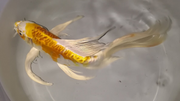
Butterfly koi, also known as longfin koi, are a stunning variation of the more traditional koi fish. With their long, flowing fins and vibrant patterns, butterfly koi stand out in any pond, adding elegance and grace to the water. Some koi enthusiasts may dismiss butterfly koi, calling them "mutts" or arguing that they aren't "true koi." However, for many collectors and pond owners, butterfly koi—or fantail koi, as they’re also known—are one of the most captivating and beautiful fish to add to their aquatic collection. In this article, we'll explore the origins of the butterfly koi, how to care for them, and why they make a fantastic choice for pond owners.
Origins of Butterfly Koi
The history of butterfly koi fish began in the early 1980s when a large population of long-finned, brown, and gray carp was discovered in Indonesia. These fish were initially brought to the United States, but they did not gain much attention because of their plain appearance. However, breeders at Blue Ridge Fish Hatchery in North Carolina started crossbreeding these long-finned carp with traditional koi, eventually creating what we now recognize as butterfly koi or big butterfly koi.
Several significant traits emerged from these breeding efforts:
- Dominant Longfin Genes: Breeders discovered that the longfin gene is dominant, meaning when crossed with regular koi, the offspring still retained the long-finned characteristic.
- Robust Health and Disease Resistance: Butterfly koi, or real butterfly koifish, were found to be more disease-resistant and hardier compared to many traditional koi varieties.
- Color Variations: Breeders successfully produced butterfly koiin a wide range of colors and patterns. These "longfin koi" eventually became known as butterfly koi because of their graceful, fluttering movements in the water.
Size and Finnage of Butterfly Koi
One of the most striking features of butterfly koi is their long, flowing fins, which continue to grow as the fish ages. The longer and more developed the fins, the more impressive the fish becomes—looking like a butterfly or a dragon gliding gracefully through the water. In fact, the fins can grow so long that the blood vessels can no longer support additional growth, giving older butterfly koi a regal appearance.
Butterfly koi may not grow as bulky as regular koi, but they can reach impressive lengths of up to 36 to 40 inches under ideal conditions. Their long, slender bodies and flowing fins make them particularly graceful swimmers, enhancing the beauty of any pond.

Patterns and Coloration
As with traditional koi, pattern and coloration are essential when determining the value of butterfly koi. A well-defined, symmetrical pattern increases the value of these fish. However, the flowing fins of butterfly koi make even imperfectly patterned fish look stunning.
Some color variations of butterfly koi, or big butterfly koi, are especially striking. Lemon and platinum ogons—solid-colored metallic varieties—are particularly beautiful as they mature. These yellow or neon-white koi fish look like comets or fireballs with their long fins trailing behind them, creating a mesmerizing effect in larger ponds.
Another popular variety is the sorogoi, a gray fish with a black net pattern on its body. As they grow, sorogoi develop a "sea monster" look, moving slowly and deliberately through the water with their long fins, creating a sense of mystery.
Perhaps the most striking butterfly koi are the black butterfly koi or doitsu karasu, a rare scaleless, black koi variety. With their jet-black bodies and long fins, these fish have a shadowy, dragon-like appearance, making them especially captivating. In Japanese culture, black koi are considered omens of good luck, adding to their appeal among pond owners.
Caring for Butterfly Koi
Pond Size and Environment
Butterfly koi, or fantail koi, thrive in ponds with plenty of space to swim and grow. A pond with a capacity of at least 1,000 gallons is ideal, especially if you plan to keep more than one big butterfly koi together. Clean, filtered water is essential to keep these fish healthy and to maintain their impressive fins. Although they are hardy and more resistant to diseases than regular koi, good water quality is crucial for their well-being.
Feeding Butterfly Koi
Like all koi, butterfly koi are omnivores and will eat a varied diet. High-quality koi pellets should make up the bulk of their diet, but they will also enjoy vegetables like lettuce and peas, as well as occasional treats like shrimp or worms. Feeding them a balanced diet will help maintain their health and vibrant coloration.
Temperature Requirements
Butterfly koi can tolerate a wide range of temperatures but prefer water temperatures between 65°F and 75°F. They can survive in colder water during winter, but their pond should be deep enough to prevent freezing at the bottom. In colder climates, a pond heater or aerator may be necessary to prevent the water from freezing completely.
Managing Fin Damage
The long fins of butterfly koi make them more prone to damage, especially during handling or netting. Damaged fins may not heal properly and can develop bends or splits. To avoid fin damage, handle the fish gently and avoid overcrowding the pond.
Health and Disease Resistance
Butterfly koi are hardy and more resistant to diseases compared to many regular koi varieties. However, it is still important to monitor water quality and provide proper nutrition to keep them healthy and stress-free.
Are Butterfly Koi Real Koi?
There has been some debate within the koi community about whether butterfly koi, or koi butterfly fish, are "true koi." While they are genetically koi, their long fins set them apart from traditional koi varieties. Over time, however, many breeders and collectors have come to appreciate the unique beauty of butterfly koi.
Initially, butterfly koi faced resistance in Japan, where koi breeding is steeped in tradition. However, as butterfly koi gained popularity in the U.S., Japanese breeders like Mr. Suda began producing them, and they eventually gained acceptance. Today, butterfly koi are bred in both Japan and the U.S. and have become a beloved choice among pond owners worldwide.
Butterfly koi, with their long fins, vibrant colors, and hardy nature, are a stunning addition to any pond. Whether you're a seasoned koi enthusiast or new to the hobby, adding butterfly koi—or longfin koi—to your collection will bring elegance and charm to your pond. From their unique origins to their mesmerizing appearance, butterfly koi, or big butterfly koi, continue to captivate the hearts of pond owners around the world. Their beauty, grace, and resilience make them a fantastic choice for anyone looking to enhance their water garden.
Bring Beauty and Serenity to Your Pond with Poposoap!
At Poposoap, we offer a variety of high-quality aquatic solutions to help you create the perfect pond environment. From pond pumps and filtration systems to pond lighting and aquatic plants, we have everything you need to maintain a healthy and stunning water feature.
Enhance your pond with our premium products to ensure your butterfly koi thrive in a clean, vibrant, and well-maintained environment. Explore our range of products today and bring your aquatic vision to life!










